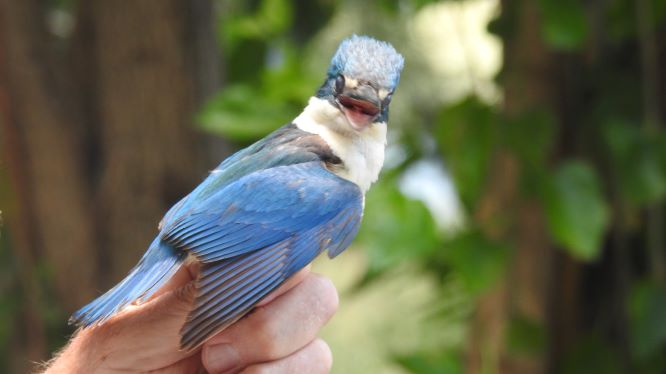Our experiences and stories as we travel Australia in our retro 80's model pop top caravan.
Susan Island Expedition

Late 2018 Miles and I had the opportunity to be citizen scientists, where we got to join a group of ecologists, bird and nature enthusiasts/nerds (ie. some very, very awesome people), to help with the final two days of a week long fauna study on an island in the Clarence River…Susan Island. Seriously, who gets to do that!!
A group of Aboriginal women, Nyami Julgaa, are recognised and acknowledged as the cultural custodians of Susan Island and I pay my respects to those women both past and present for who this island holds deep cultural connection.
The western end of Susan Island is home to the largest remnant of lowland subtropical rainforest in the Clarence Valley, (just 16.5 hectares) which was once, prior to European settlement, extensive along the banks of coastal rivers. It is also home to a large colony of Grey Headed Flying fox who use the island as a nesting and breeding area. The rest of the island was largely, and sadly, cleared to become grazing land for cattle during settlement years. Despite many years of regeneration work, much of the island is still vanquished by aggressive, introduced weeds.
The ongoing fauna study on Susan Island began in 1998, and is completed every 10 years by Dr. Greg Clancy. While mainly focusing on the bird species present and their populations, it also looks at all other present fauna such as bats, rodents and reptiles. Susan Island is home to over 100 species of birds, over 50 native tree species, plus many vines and ferns. Up until the 1920’s Koalas, Pademelons and other small ground dwelling animals were found on the island, however foxes and human activity led to their demise.

Expedition Susan Island…
Carrying what seemed like half of our belongings in my pack (seriously I resembled a gypsy peddler), we caught a ride over to the island in a tinny with National Parks and Wildlife Service.
Once at the island we were greeted by Greg, with an exuberant “Welcome to the Island!”. After quick introductions and a walk-around the camp/work site, we hit the ground running (well Miles did most of the running), as something was spotted in one of the bird nets. At first sight it was thought it might have been a bat…aka grey headed flying fox, but Miles set them straight…”It’s definitely not a bat, it has feathers”. Greg rushed to retrieve the mystery animal to find this beauty… a Brown Goshawk! We definitely felt pretty special getting to see one of these amazing birds up so close!!


The day continued in a flurry; setting up our tent, regularly and excitedly checking bird nets, recovering trapped birds, processing birds (determining species, sex, and age), banding and documenting them, taking their happy snaps, and setting them free. Oh, and of course listening to Greg’s many yarns.
Miles took his job super seriously, running every 20 minutes to check nets, and calling back to Greg on the walkie talkie if any birds were found. He was totally in his element and loving every minute.
So here are a few pics of the beautiful little guys and girls we found.

Eastern Yellow Robin 
Australian Golden Whistler


Sacred Kingfisher 
Little Shrikethrush


Rufous Fantail 
Red-backed Fairywren
The day didn’t end when the sun went down. Late that night we went spotlighting, looking for night birds and animals. We took out some highly sophisticated technology; a 90’s relic CD walkman, and speakers hooked up to a battery; that played calls of night birds in hope of attracting some birds, or at least encourage them to call back. We did spot a female Tawny Frogmouth, and later when playing the callback CD her mate flew in, swooping silently between mine and Miles heads…so close I felt the air move as it glided past.

The second day was a bit quieter on the bird front, although we were kept busy helping retrieve all the ground traps that had been laid for ground dwelling animals, and packing up camp. We did happen to spot two Coastal Carpet Pythons, a Lace Monitor napping up a tree, and a stunningly beautiful and extremely large Fig tree.

Coastal Carpet Python 
Lace Monitor 
Butress roots of a fig tree
The biggest finding from the study was the increase in native swamp rat numbers in the past 10 years…likely due to the eradication of the introduced common rat which had previously decimated native species.
While there is no camping permitted on the island and no facilities available, you are able to visit the reserve on the western end of the island and walk through the rainforest trail. Access to Susan Island Nature Reserve is by boat from Grafton area. If you do decide to visit please be mindful not to disturb the bat colony roosting in the rainforest area, and also be wary of the giant stinging tree that can, if you get the fibreglass like nettles on your skin, lead to painful and long lasting skin irritation.
Massive thanks and appreciation to Greg for allowing us to be part of the study and history of Susan Island. We were super grateful for the opportunity and time given to share knowledge with us, and loved hanging out with, and learning from super passionate, lovely, intelligent folk.
Until our next adventure, Daniela & Miles xx



Recent Comments